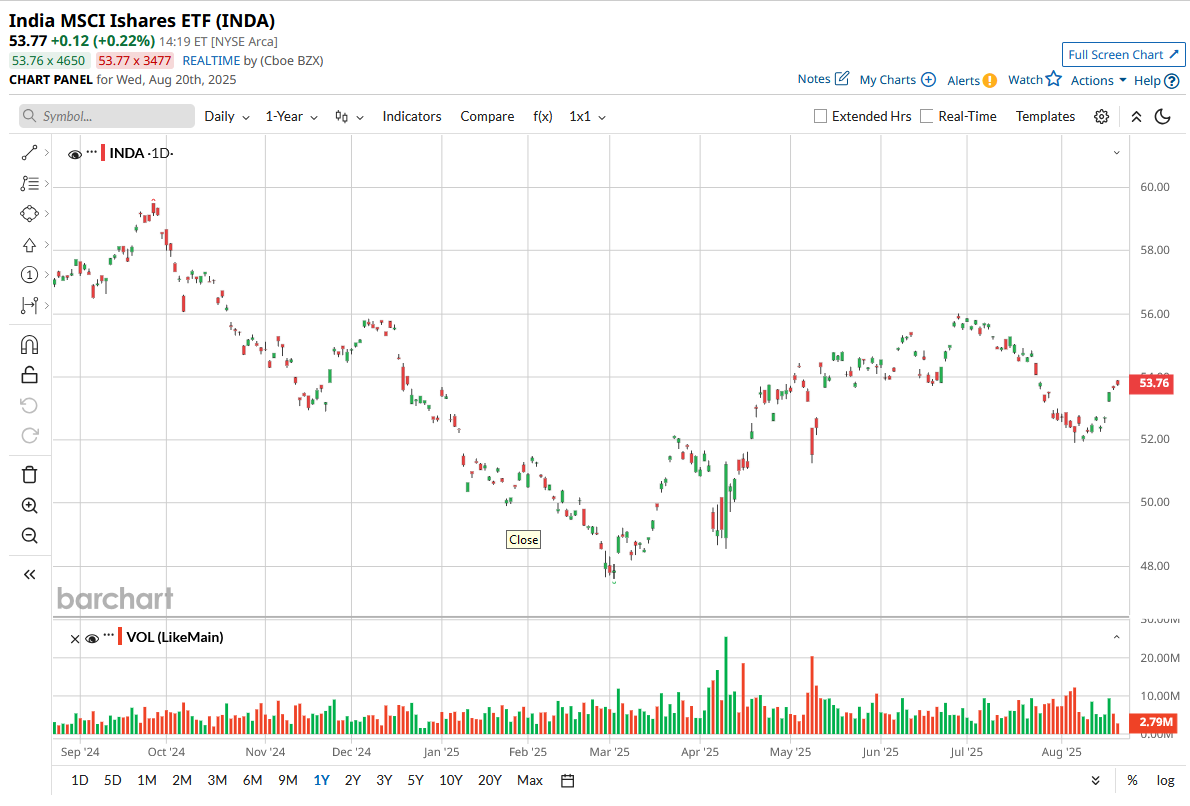
India’s stock market has suddenly become the epicenter of global investment excitement, capturing headlines as flows from around the world smash previous records. In July 2025 alone, Indian equities attracted an eye-popping $4.9 billion (427 billion rupees) in net inflows, even as foreign funds pulled out $3 billion.
India’s economy is currently attracting a surge of both international and domestic capital, demonstrating resilience against various challenges. This robust growth is bolstered by strong manufacturing performance, a buoyant rupee against the dollar, and effective policy measures that mitigate the impacts of rising tariffs and an unpredictable global trade environment.
Mutual fund inflows have soared to all-time highs, and the local stock market continues to post new peaks, cementing India as the “bright spot” amid tumult across Asia and beyond.
Front and center in this investment renaissance stands the iShares MSCI India ETF (INDA). As one of the largest and most liquid ways for global investors to tap directly into India’s equity pulse, INDA provides broad, efficient exposure to the country’s economic leaders and emerging champions.
But as money pours in at a historic pace and optimism runs high, a pressing question emerges: Is INDA the smartest bet for riding this unprecedented growth? Let’s find out.
Overview of India MSCI iShares ETF (INDA)
The India MSCI iShares ETF finds its edge in a thoughtfully constructed, passive indexing approach, closely replicating the MSCI India Index. INDA typically allocates at least 80% of its assets to companies featured in the MSCI India Index, with representation in banking, technology, energy, consumer staples, and beyond. Notably, the fund resists any urge to react defensively during downturns or chase outperformance.
Instead, it simply mirrors the actual market makeup, an approach designed to keep exposure clear, direct, and true to the underlying Indian economy. Part of the BlackRock (BLK) iShares family, INDA launched on Feb. 2, 2012, and has accumulated a sizable asset pool totaling about $9.96 billion. Investors in the fund benefit from an annual dividend of $0.40 and a dividend yield of 0.76% right from the start, making income generation a quiet, steady feature of this ETF.
Currently, INDA is priced at $53.77 per share, with a small, but notable, year-to-date gain of 2%, even though it has seen a dip of 5% over the past 52 weeks.

When talking about holdings, INDA balances breadth with focus. The fund holds 165 stocks, but noteworthy concentration exists in the top 10, which together account for 38.61% of total allocation. The largest weighting goes to HDFC Bank (8.6%), Reliance Industries (6.38%), ICICI Bank (5.74%), Infosys (3.67%), Bharti Airtel (3.67%), BLK CSH FND Treasury SL Agency (3.65%), Mahindra and Mahindra (2.32%), Tata Consultancy Services (2.09%), Larsen and Toubro (1.89%), and Axis Bank (1.87%).
Over the past year, it has maintained an active presence, with average monthly trading volumes reaching 7,126,472, evidence of consistently strong activity and deep liquidity. The ETF maintains a management fee of 0.64%, situating itself in a competitive spot among international funds focused on emerging markets.
Catalysts Driving Record Inflows
Policy support and targeted economic measures are driving a sustained surge in local equities, and momentum could soon build even further. Expectations for a potential rate cut by the U.S. Federal Reserve in September 2025 are high, with the CME’s FedWatch tool indicating an 87.4% probability of a 25-basis-point reduction. A move like this typically encourages more foreign capital to flow into emerging markets such as India, adding to domestic liquidity and supporting higher valuations.
The India Union Budget 2025-26 placed a clear emphasis on accelerating job creation and boosting infrastructure investment, sending significant capital into manufacturing, green energy, and technology sectors, all with the intent of expanding employment and fueling domestic demand.
Currency momentum this August gives further support as the rupee strengthened 0.37% against the U.S. dollar in the last five sessions, since Aug. 11, 2025, a notable gain that improves capital predictability and insulates local assets from depreciation risk. This upturn in the rupee is a meaningful draw for anyone seeking consistency in currency returns.
India’s growth just strengthened as its GDP expanded 6.2% in the December quarter of FY25. That was up from 5.6% in the prior quarter, snapping a two-quarter slowdown and offering a dose of optimism.
There’s strong evidence that the pickup goes beyond headline numbers. Systematic investment plans and new equity schemes continue drawing broad participation, and the government’s boost to “Make in India” manufacturing is bringing in new capacity and dynamism from both home-grown and multinational companies.
Conclusion
India’s stock market has real momentum and all the major catalysts, from strong economic growth to currency gains and bold infrastructure spending, look set to keep fueling the story. For a simple way to get broad, liquid exposure to the story, one ETF, INDA, stands out as the practical choice in this market. With so much capital pouring in and policy working in favor of local companies, shares are much more likely to keep moving up in the near term, especially if these trends hold. For anyone on the fence, now’s probably not the time to sit out. Over the next few months, shares are more likely to grind higher than roll over, choppy, but constructive.







